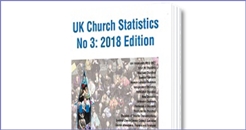 Where is the UK Church going?
Where is the UK Church going?
Peter Brierley recently published his latest research into UK Church trends - UK Church Statistics No 3: 2018 Edition.
It gives an overview of church life in the UK (across all four countries) culled from a thorough survey of church membership, churches and congregations, and the number of ministers, covering the individual years between 2012 and 2017. It then gives a forecast through for the next five years to 2022.
Here is a very brief overview:
While the overall numbers of Church attendees continue to decline, there are a number of areas where growth is occurring, although overall the future still shows a downward line. By 2030, membership of Christian churches in the UK will likely still be over 7% of the adult population.
There were some 50,500 churches in the UK In 2017. Not all the churches are buildings, as some congregations meet in homes, schools, rooms in pubs, village halls and other places. Perhaps 42,000 are actual buildings.
UK Denominations
There are 257 denominations in the UK, rather less than the 290 in 2013 listed in the previous volume. The main decline in number of individual denominations is among the Pentecostal mega-group. The Charity Commission’s register of annual returns reveals that a number of these denominations have made no returns over the last five years or so and that they no longer have a live website. It remains true, however, that the comment by Dr Joe Aldred, the Pentecostal and Multicultural Relationship Officer at Churches Together in England, that there could be as many as 8,000 Pentecostal churches in the UK is perhaps correct (Peter lists only 4,000), since tracking these churches is incredibly difficult.
Growth
One key factor over the last few years is the fact that a number of denominations have seen substantial growth. This stems from various factors:
-
The FIEC, for instance, launched its Church Revitalisation programme. The consequence was a 10% increase in church membership, offset by reducing numbers in some denominations.
-
A key cause of growth in other areas is through the number of immigrants coming to the UK and numbers from some countries are especially important for some denominations e.g. Polish Catholics, Black African Pentecostals, Romanian Orthodox, etc.
-
A third group of growing churches are those especially concerned with evangelism, including; Hillsong focussing especially on young people, Messy Church which has more than doubled its numbers since 2012, Churches of Christ, some of the New Churches like Multiply Network and Vineyard both of which have grown over 30% in the last 5 years.
Decline
The Church of England (1,170,000 members in 2012 declined -19% between 2012 and 2017)
The Church in Wales (55,000 members; -23%)
The Scottish Episcopal Church (35,000 members; -30%)
The Baptist Union of Wales (13,000; -19%)
The Roman Catholic Church in Scotland (130,000; -17%)
The Union of Welsh Independents (20,000; -18%)
The Methodist Church of Great Britain (181,000; -16%)
The Presbyterian Church of Wales (19,000; -26%)
The Church of Scotland (307,000; -26%)
Of these nine more rapidly declining denominations, only two are in England, the rest in Wales or Scotland.
Gender
The proportion of female ministers rises from 9% in 1995 to 16% in 2017 and rising to 17% by 2030 if present trends continue.
Women are especially prevalent among Messy Church (56% in 2017), the Salvation Army (49%), Methodist (39%) and Anglican (28%) leadership, but are also present in Presbyterian (18%), New Churches (17%), Pentecostal (14%), Baptist (13%), Independent Churches (5%) and other Small Denominations (2%).
More details are here.
Retweet about this article:
From UK Church Stats 2018, 09/01/2018